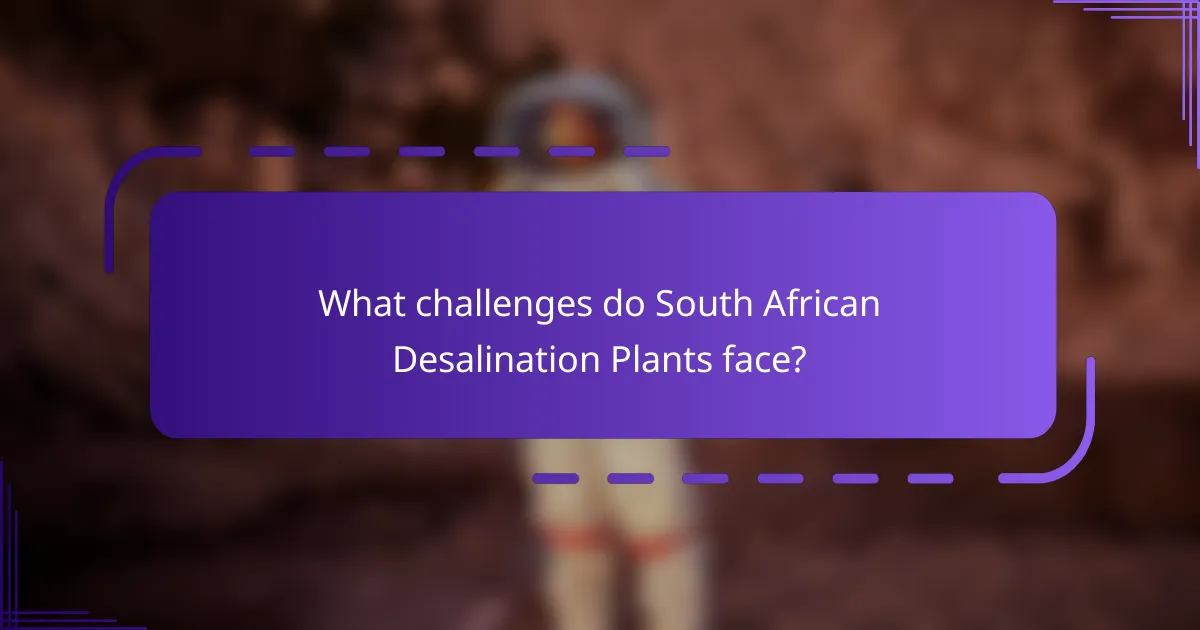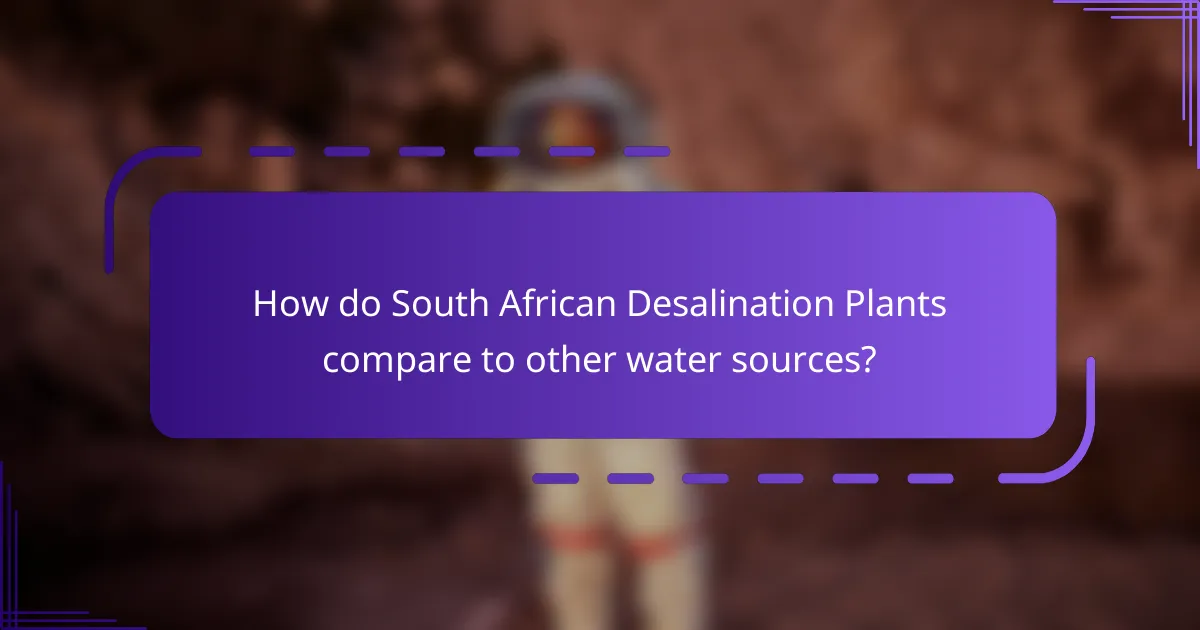South African desalination plants are facilities designed to convert seawater into potable water, addressing the pressing issue of water scarcity in coastal regions. Utilizing technologies such as reverse osmosis, these plants are crucial for providing a reliable source of drinking water, particularly in urban areas like Cape Town and Durban. While they offer significant benefits, including independence from rainfall and the ability to supplement traditional freshwater sources, these plants face challenges such as high operational costs, energy consumption, and environmental concerns related to brine disposal. The article will explore the processes, advantages, and obstacles associated with desalination in South Africa, providing a comprehensive overview of its role in water security.

What are South African Desalination Plants?
South African desalination plants are facilities that convert seawater into potable water. These plants are crucial for addressing water scarcity in coastal regions. They utilize various technologies, such as reverse osmosis, to remove salt and impurities from seawater. South Africa has several operational desalination plants, including those in Cape Town and Durban. The Cape Town desalination plant was built in response to a severe drought in 2017. This facility can produce up to 7 million liters of drinking water per day. Desalination helps supplement freshwater sources, especially during dry seasons. It plays a significant role in ensuring water security for urban populations.
How do South African Desalination Plants function?
South African desalination plants function by removing salt and impurities from seawater to produce fresh water. The process typically involves several key stages. First, seawater is drawn into the plant through intake systems. Next, the water is pre-treated to remove larger particles and contaminants. This is often done using filtration methods.
After pre-treatment, the water undergoes reverse osmosis. In this stage, water is forced through semi-permeable membranes that block salt and other impurities. The result is fresh water on one side of the membrane and concentrated brine on the other.
Finally, the fresh water is post-treated to ensure it meets health standards. This may involve adding minerals and disinfectants. The brine is usually discharged back into the ocean, carefully managed to minimize environmental impact.
These plants are crucial for addressing water scarcity in regions like South Africa, where traditional water sources are limited.
What technologies are used in South African Desalination Plants?
South African desalination plants primarily use reverse osmosis technology. This method involves forcing seawater through a semi-permeable membrane to remove salts and impurities. Another technology used is multi-stage flash distillation, which heats seawater to create steam, then condenses it into fresh water. Electrodialysis is also employed, using electric currents to move ions through selective membranes. These technologies are crucial for addressing water scarcity in South Africa. The country has invested in these systems to enhance water supply, particularly in coastal regions.
What are the key processes involved in desalination?
The key processes involved in desalination are reverse osmosis, distillation, and electrodialysis. Reverse osmosis uses a semi-permeable membrane to separate salt and impurities from water. High pressure forces seawater through the membrane, producing freshwater. Distillation involves heating seawater to create steam. The steam is then cooled to condense into freshwater, leaving salt behind. Electrodialysis utilizes electric currents to move ions through selective membranes, separating salt from water. Each process effectively reduces salinity, making water suitable for consumption.
What are the benefits of South African Desalination Plants?
South African desalination plants provide several key benefits. They address water scarcity issues in coastal regions. These plants convert seawater into potable water, ensuring a reliable water supply. Desalination helps reduce dependence on traditional freshwater sources. It supports agricultural and industrial needs during droughts. The technology can be scaled to meet varying demands. Additionally, these plants can enhance local economies by creating jobs. Evidence from the 2017 Cape Town water crisis highlights their importance in emergency situations.
How do South African Desalination Plants contribute to water security?
South African desalination plants enhance water security by converting seawater into potable water. This process addresses water scarcity in coastal regions. These plants provide a reliable alternative water source, especially during droughts. They help meet the increasing demand for fresh water due to population growth. Desalination can supplement existing freshwater supplies from rivers and reservoirs. In South Africa, several plants have been established, including those in Cape Town and Durban. These facilities can produce millions of liters of drinking water daily. By diversifying water sources, they reduce reliance on traditional freshwater systems.
What environmental benefits do South African Desalination Plants provide?
South African desalination plants provide several environmental benefits. They help reduce pressure on freshwater resources. By converting seawater into potable water, they alleviate water scarcity issues in coastal regions. This process minimizes the reliance on groundwater and surface water sources. Desalination can also support local ecosystems by providing a stable water supply. Furthermore, these plants often incorporate energy-efficient technologies. These technologies can reduce carbon emissions associated with water supply. Overall, desalination contributes to sustainable water management in South Africa.

What challenges do South African Desalination Plants face?
South African desalination plants face several challenges. High operational costs significantly impact their sustainability. The energy-intensive nature of desalination increases electricity consumption. Limited freshwater resources complicate the sourcing of seawater. Environmental concerns arise from brine disposal into oceans. Infrastructure development often encounters regulatory hurdles. Public perception and acceptance of desalination technologies remain mixed. These challenges hinder the growth and efficiency of desalination efforts in South Africa.
What are the economic challenges associated with South African Desalination Plants?
South African desalination plants face significant economic challenges. High capital costs for construction and technology are primary issues. Operating expenses, including energy consumption, also contribute to financial burdens. Limited funding and investment hinder the development of new projects. Economic viability is often questioned due to the high cost of desalinated water compared to traditional sources. Additionally, fluctuating energy prices can impact operational costs. Environmental regulations may impose further financial constraints on operations. These factors collectively challenge the sustainability of desalination efforts in South Africa.
How do operational costs impact the viability of desalination?
Operational costs significantly impact the viability of desalination. High operational costs can deter investment in desalination projects. These costs include energy consumption, maintenance, and labor. Energy costs are particularly critical, as desalination is energy-intensive. For example, reverse osmosis requires substantial electricity to operate pumps. If energy prices rise, the overall cost of desalination increases. This can make desalinated water more expensive than other water sources. Additionally, maintenance costs can vary based on technology and plant age. High maintenance expenses can further strain budgets. Therefore, managing operational costs is essential for the economic feasibility of desalination.
What funding options are available for South African Desalination Plants?
Funding options for South African desalination plants include government grants, private investments, and international loans. The South African government often allocates funds for water infrastructure projects. Private investors may partner with public entities to finance desalination initiatives. Additionally, international financial institutions provide loans specifically for water projects. For example, the World Bank and African Development Bank have funded similar ventures in the region. These funding avenues support the development and sustainability of desalination technologies in South Africa.
What environmental concerns are linked to South African Desalination Plants?
Environmental concerns linked to South African desalination plants include marine ecosystem disruption, brine disposal issues, and energy consumption impacts. The intake of seawater can harm marine life, particularly fish and other organisms. Brine, a byproduct of desalination, is often discharged back into the ocean, increasing salinity and potentially affecting local habitats. Studies indicate that high salinity levels can lead to decreased biodiversity in marine environments. Additionally, the energy required for desalination contributes to carbon emissions, raising concerns about climate change. The reliance on fossil fuels for energy exacerbates these environmental challenges.
How does brine disposal affect marine ecosystems?
Brine disposal negatively affects marine ecosystems by increasing salinity levels in surrounding waters. Elevated salinity can harm marine organisms, particularly those sensitive to changes in salinity. For example, fish and invertebrates may struggle to survive in hyper-saline conditions. Additionally, brine can contain harmful chemicals and heavy metals from the desalination process. These contaminants can accumulate in marine life, leading to toxic effects. Research indicates that areas near brine discharge points often experience reduced biodiversity. Studies show that species richness declines as salinity increases, disrupting local food webs. Overall, improper brine disposal poses significant risks to marine health and biodiversity.
What measures are in place to mitigate environmental impacts?
Desalination plants in South Africa implement several measures to mitigate environmental impacts. These measures include the use of advanced filtration systems to reduce the intake of marine life. Additionally, brine discharge is carefully managed to minimize salinity levels in surrounding waters. Regular environmental impact assessments ensure compliance with regulations. Energy-efficient technologies are adopted to lower carbon emissions. Furthermore, community engagement programs educate local populations about sustainability. These actions collectively aim to balance water needs with environmental preservation.

How do South African Desalination Plants compare to other water sources?
South African desalination plants provide a reliable source of potable water, especially in arid regions. They convert seawater into fresh water through processes like reverse osmosis. This method is increasingly necessary due to the country’s water scarcity issues. In comparison, traditional water sources include rivers, lakes, and groundwater. These sources are often subject to pollution and seasonal variability. Desalination plants can operate independently of rainfall, ensuring a consistent supply. However, they are energy-intensive and costly to operate. The average cost of desalinated water in South Africa is approximately 15 to 20 rand per cubic meter. In contrast, conventional water sources can be less expensive but may not always meet demand. Thus, while desalination is a viable alternative, it complements rather than replaces traditional water sources.
What are the advantages of desalination over traditional water supply methods?
Desalination offers several advantages over traditional water supply methods. It provides a reliable source of freshwater from abundant seawater. This process is particularly beneficial in arid regions where freshwater sources are limited. Desalination can help mitigate the impact of droughts on water supply.
Additionally, desalination plants can be located near coastal areas, reducing the need for extensive water transport infrastructure. The technology can also be scaled to meet varying water demands. Furthermore, desalination contributes to water security by diversifying water supply sources.
According to the International Desalination Association, over 300 million people rely on desalinated water globally. This demonstrates the effectiveness of desalination in addressing water scarcity challenges.
How does the reliability of desalination compare to surface water sources?
Desalination is generally more reliable than surface water sources. Surface water sources can be affected by seasonal variations, pollution, and climate change. In contrast, desalination provides a consistent supply of freshwater regardless of weather conditions. According to the World Bank, desalination plants can operate continuously, producing up to 90 million cubic meters of water daily. This reliability is crucial in arid regions like South Africa, where droughts can severely impact surface water availability. Additionally, desalination technology has advanced, making it more efficient and cost-effective over time.
What role do desalination plants play in drought management?
Desalination plants play a critical role in drought management by providing an alternative source of freshwater. They convert seawater into potable water, which can supplement limited freshwater supplies during drought conditions. In regions like South Africa, where water scarcity is prevalent, these plants can help meet the rising demand for water. For instance, the Cape Town desalination plant was established to address severe water shortages during the 2017-2018 drought. This facility produced approximately 7 million liters of drinking water per day, directly alleviating the impact of the drought. By diversifying water sources, desalination plants enhance water security and resilience against future droughts.
What future developments are anticipated for South African Desalination Plants?
Future developments anticipated for South African desalination plants include increased capacity and advanced technology integration. Investments are expected to enhance desalination efficiency and reduce operational costs. The government aims to implement renewable energy sources to power these plants. This shift will decrease reliance on fossil fuels and lower carbon emissions. Furthermore, research into innovative desalination methods is ongoing. Technologies like solar desalination and reverse osmosis are being explored. These advancements will help address water scarcity in coastal regions. Collaborative projects with international partners may also emerge to share expertise and resources.
How might advancements in technology improve desalination efficiency?
Advancements in technology can significantly improve desalination efficiency. Innovations such as reverse osmosis membranes enhance water permeability and reduce energy consumption. Improved materials for membranes can increase durability and reduce fouling. Smart sensors and AI can optimize operational parameters in real-time, leading to better energy management. Solar desalination techniques are becoming more viable, utilizing renewable energy to power the process. Research indicates that these technologies can lower the cost of desalinated water by up to 30%. Enhanced energy recovery systems can also minimize waste and improve overall efficiency. These advancements collectively contribute to more sustainable and cost-effective desalination solutions.
What policy changes could enhance the operation of desalination plants?
Implementing stricter environmental regulations could enhance the operation of desalination plants. These regulations would ensure sustainable practices and minimize ecological impacts. Additionally, providing financial incentives for innovation can promote advanced technologies. This could lead to improved efficiency and reduced operational costs. Streamlining permitting processes would accelerate project timelines. Efficient project execution is crucial for addressing water scarcity quickly. Enhancing public-private partnerships can also foster investment and collaboration. This approach can leverage resources and expertise from both sectors. Finally, establishing clear water pricing policies can promote responsible water use. This encourages conservation and supports the economic viability of desalination projects.
What best practices should be followed for managing South African Desalination Plants?
Effective management of South African desalination plants requires adherence to several best practices. Regular maintenance of equipment ensures optimal performance and longevity. Implementing energy-efficient technologies reduces operational costs and environmental impact. Monitoring water quality is crucial to meet health standards and regulatory compliance. Training staff on operational protocols enhances safety and efficiency. Establishing a contingency plan for emergencies ensures quick response to system failures. Collaborating with local communities fosters support and understanding of desalination benefits. Utilizing renewable energy sources can improve sustainability and reduce reliance on fossil fuels. These practices contribute to the successful operation of desalination facilities in South Africa.
South African desalination plants are facilities designed to convert seawater into potable water, addressing critical water scarcity issues in coastal regions. The article outlines the technologies employed, such as reverse osmosis and multi-stage flash distillation, and highlights the key processes involved in desalination. It also discusses the benefits these plants provide, including enhanced water security and economic opportunities, while addressing the challenges they face, such as high operational costs and environmental concerns. Additionally, the article examines future developments and best practices for managing these essential water resources.